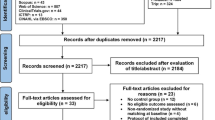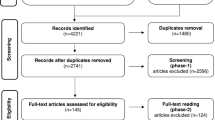Abstract.
Despite intensive research regarding the position of the temporomandibular joint, only few evidence-based facts are known about a three-dimensional physiological condyle-fossa relationship. The aim of this systematic literature review was therefore to summarize the existing literature regarding the condyle position and to draw conclusions about a standardized three-dimensional condyle position.
An extended search profile based on the search strategy of the Cochrane Oral Health Group and applied to twelve medical databases was used to identify existing studies. Articles which were not electronically accessible (mainly those published before 1960) were identified from reference lists and bibliographies. These publications were assessed independently by two clinicians with reference to points based on specified criteria. The interexaminer agreement was assessed on the basis of the kappa \( \overset{\lower0.5em\hbox{$\smash{\scriptscriptstyle\frown}$}}{\kappa } \) coefficient.
1903 articles published in the period 1899–2001 and relating to condyle position were identified. These studies showed a pronounced variability in their methodological approaches, with only 49 of them meeting the inclusion criteria. The interexaminer agreement yielded a \( \overset{\lower0.5em\hbox{$\smash{\scriptscriptstyle\frown}$}}{\kappa } \)-value of 0.92. Although numerous studies used three-dimensional data, no physiological three-dimensional condyle position was determined. The most frequent analytic method was two-dimensional projection of the temporomandibular joint onto a subjectively selected sagittal plane. This evaluation method revealed a noticeable shift over time in condyle position from posterior to anterior, suggesting a clear-cut publication bias. Publications with the highest evidence level favored no specific position (p > 0.05).
Simplification of the three-dimensional structure of the temporomandibular joint to a two-dimensional projection is questionable for therapeutic positioning of the condyle in relation to the fossa.
Zusammenfassung.
Trotz intensivster Forschung zur Gelenkposition existieren bisher nur wenige evidente Fakten über eine dreidimensionale physiologische Position des Kondylus zur Fossa. Ziel dieser systematischen Übersichtsarbeit ist es daher, die bestehenden Studien zur Evaluierung der Gelenkposition zusammenzufassen und daraus Rückschlüsse auf eine dreidimensional normierte Gelenkposition zu ziehen.
Zur Identifikation vorhandener Studien wurde mit einem erweiterten Suchprofil auf Basis der Suchstrategie der Cochrane Oral Health Group auf zwölf medizinische Datenbanken zugegriffen. Artikel, die elektronisch nicht zugänglich waren (vorwiegend Publikationen vor 1960), wurden über Literaturverzeichnisse und Bibliotheksbände identifiziert. Die Beurteilung der Studien erfolgte anhand von Punkten nach festgelegten Kriterien und unabhängig durch zwei Untersucher. Der Grad an Übereinstimmung der Untersucher wurde anhand des Kappa-(\( \overset{\lower0.5em\hbox{$\smash{\scriptscriptstyle\frown}$}}{\kappa } \) -)Koeffizienten beurteilt.
Aus dem Zeitraum 1899–2001 konnten 1903 Artikel mit Bezug zur Kondylenposition identifiziert werden. Diese Studien zeigen eine große Variabilität der methodischen Ansätze, so dass anhand der definierten Kriterien 49 Studien inkludiert wurden. Die Untersucherübereinstimmung ergab einen \( \overset{\lower0.5em\hbox{$\smash{\scriptscriptstyle\frown}$}}{\kappa } \)-Wert von 0,92. Trotz zahlreicher Studien, die dreidimensionale Daten verwendeten, konnte keine dreidimensionale physiologische Gelenkposition eruiert werden. Die häufigste Analysemethode war die zweidimensionale Projektion des Kiefergelenkes auf eine subjektiv gewählte sagittale Schnittebene. Bei dieser Auswertungsmethode zeigte sich eine deutliche historische Wandlung der Kondylenposition von posterior nach kranioventral, so dass von einem deutlichen „publication bias“ ausgegangen werden kann. Studien mit dem höchsten Evidenzgrad favorisierten keine bestimmte Position (p > 0,05).
Die Simplifizierung der dreidimensionalen Struktur des Kiefergelenkes auf eine zweidimensionale Projektion ist für therapeutische Positionierungen des Kondylus zur Fossa fragwürdig.
Similar content being viewed by others
Author information
Authors and Affiliations
Corresponding author
Rights and permissions
About this article
Cite this article
Stamm, T., Hohoff, A., van Meegen, A. et al. On the Three-Dimensional Physiological Position of the Temporomandibular Joint. J Orofac Orthop 65, 280–289 (2004). https://doi.org/10.1007/s00056-004-0402-3
Received:
Accepted:
Issue Date:
DOI: https://doi.org/10.1007/s00056-004-0402-3




